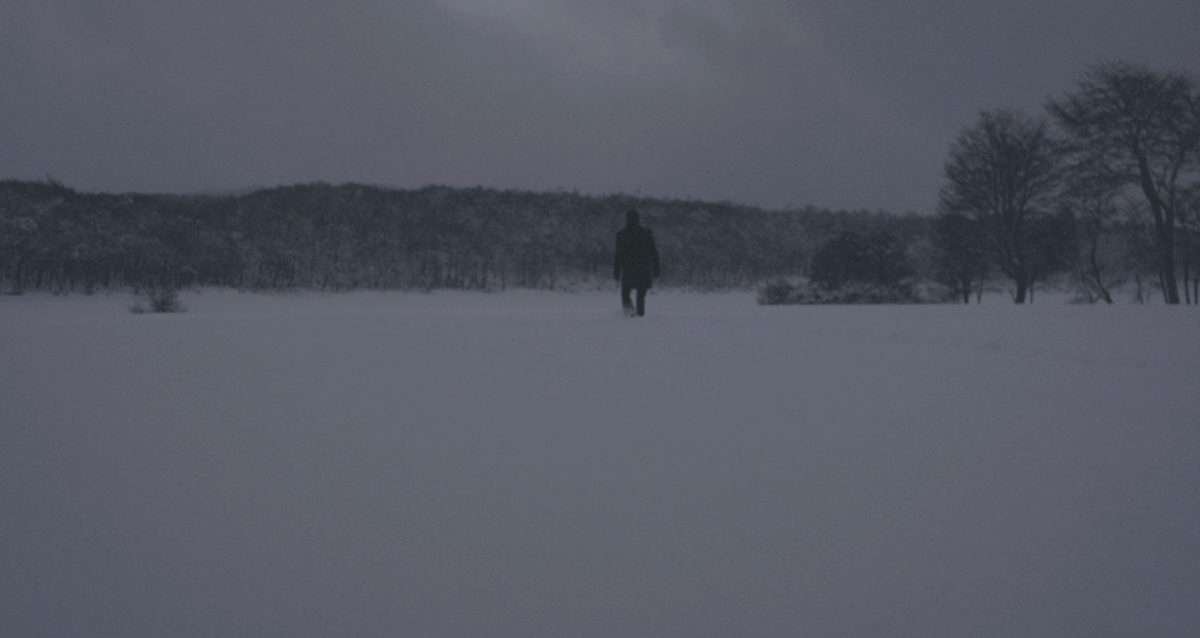Set some point after the turn of the 20th century, Blanco en blanco (2019) takes us to a time and place with a vastly different economy of images. Working with a large-format camera, Pedro, a photographer hired by a mysterious Mr. Porter, arrives in the desolate Tierra del Fuego with an assignment to create marriage portraits, only to learn that the groom will not be present for the pictures. Through the reenactment of a fictionalized history, Théo Court brings forward compelling ideas about the truth of historical documents, the manipulation of reality for art’s sake, and the price paid for images, delivered through a series of rigorous compositions that manifests the power of nature through light and landscape.
The first portrait Pedro takes on the property is of Sara, the bride-to-be on the precipice of puberty. She enters the gloomy room as Pedro sets up his camera to capture the image. He repeatedly has the housekeeper, Aurora, adjust Sara’s pose, manipulating the reality in front of his lens until the one he seeks to create emerges. Pedro removes the lens cap, slowly counts to fifteen, and then covers the lens again, his exposure finished. Soon after, he prints and presents the image to one of Mr. Porter’s men, who gives him half of their agreed-upon sum. The other half is due after the wedding, though when Pedro enquires as to when it will take place, he receives no clear answer.
While waiting for the wedding, Pedro makes acquaintance with one of Mr. Porter’s workers, an unnamed bearded man who only speaks English (all other characters speak Spanish) in a curiously unidentifiable accent. The worker tells Pedro to come to him if he has any issues, because Mr. Porter is always unreachable, before asking “what do you think my portrait would look like?” The moment serves as a reminder that these images incur a cost that few can pay, yet Pedro is soon commissioned to make images of the people of the property.
To visualize the image-making process, Court breaks from the static wide shots (a 2.35:1 ratio) that dominate the film and cuts into the aspect ratio of the large format camera (1.3:1). The action in this sequence unfolds through the lens of Pedro’s camera as he stages several photographs, making images of the hunters, the domestic workers (Aurora and three native women prisoners), the bearded man, and the landscapes. A lonely violin accompanies these images in the film’s only instance of non-diegetic sound. The effect is an absurd dissonance as we watch the process of reality being transformed into images, though we never see the results. The sequence ends by cutting back to a wide shot with Pedro and his camera pointed at the audience as fog fills the screen and nature imposes itself on the image, swallowing it in a haze of gray.
Interstitial landscape shots mark the boundaries between scenes, creating a sense of ambiguous temporality that forces the audience to glean details from the amount of available light, the presence of snow, the contours of the mountains. The season slowly shifts from winter to spring, and Pedro remains at the property, waiting for the wedding, though conversations with the bearded man have revealed Mr. Porter intentions for the property to be the beginning of a colony, with plans for a church, social hierarchies, and the subjugation of the natives.
During this time, Pedro also develops an uncomfortable fascination with Mr. Porter’s young fiancée. He displays a remarkable lack of awareness when he asks Aurora to give a necklace with his mother’s hair to Sara, and despite Aurora’s refusal (“What would Mr. Porter think?”), he eventually convinces her to help him stage another photograph of Sara. “It could be a beautiful image”, he says, before once again severely overstepping his boundaries during the shoot. He orchestrates his own reality, stripping off Sara’s dress and socks, pulling the straps of her underdress below her shoulders, even going as far as applying his saliva to her lips to give it some extra shine. He sexualizes her, manifesting his vision of beauty at a steep cost.
First comes a vicious beating delivered by two of Mr. Porter’s men. Then, word is received that the wedding is cancelled. Trapped by the boundless, inescapable landscape, he is forced into a new assignment: to document the colonization that Mr. Porter has ordered. With the snow melted and frost thawed, Pedro accompanies a group of hunters who set out into the vast terrain and slaughter a group of natives.
Ever the artist, Pedro begins to create his reality once again. The shot returns to the POV of his camera as he dances around the screen for minutes, moving the men around, having them point their guns at an out-of-frame nothingness, stripping and arranging the bodies of the dead natives so that it’s no longer clear they were shot in the back while running away, all in a race against the setting sun to create a version of history that makes art from death before the image escapes.
As the sun disappears behind the mountainous horizon, Pedro starts his final exposure. While counting to ten, a gust of wind blows up huge clouds of dust that obscure the rigorously framed and orchestrated bodies. When he yells “it’s over” and finishes his exposure, it remains unclear whether the photograph with the highest cost of all has yielded anything of worth. Court cuts to white and we are left to reconcile with the images of history, the prices paid for them, and ultimately the veracity of the truth that has been co-opted today.
